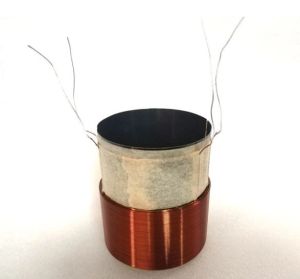Voice Coil

Voice coil, an essential speaker component, is responsible for converting electrical signals into sound waves. Here's a breakdown of its structure and function:
Construction[edit | edit source]
- Coil Wire: Usually crafted from copper or aluminum, this wire is wound around a cylindrical former. Insulation ensures no short circuits occur between wire turns.
- Former: This core, often made from aluminum or paper, provides a base for the wire. Its material must be both lightweight and heat-resistant.
- Magnet: Permanent magnets, like neodymium or ferrite, generate the magnetic field necessary for the coil's operation.
Operation Principle[edit | edit source]
Voice coil relies on electromagnetism and the Lorentz force. An alternating current, representing the audio signal, flows through the coil, creating a dynamic magnetic field. This field interacts with the static field of the permanent magnet, producing a push-pull force.
- Electrical Signal: Alternating current from the audio signal enters the voice coil.
- Magnetic Interaction: The coil's magnetic field engages with the permanent magnet's field.
- Mechanical Movement: The resulting force moves the coil and the attached cone, generating sound waves.
Impact on Sound Quality[edit | edit source]
Voice coil design influences speaker performance. Key aspects include:
- Power Handling: The capacity to endure power without overheating or distorting.
- Impedance: Typically 4, 8, or 16 ohms, this affects interaction with amplifiers.
- Frequency Response: Effective operation across designed frequency ranges is crucial.
- Sensitivity: Determines sound output level for given input power, enhancing efficiency.
Advanced Materials and Technologies[edit | edit source]
Modern improvements include:
- Kapton Formers: High heat resistance.
- Flat Wire Coils: Increased packing density and magnetic interaction.
- Advanced Cooling Techniques: Better heat dissipation for higher power handling.
Voice coil, at the heart of a speaker, transforms electrical energy into the mechanical motion that produces our cherished sounds. Hopefully, this sheds light on its vital role!